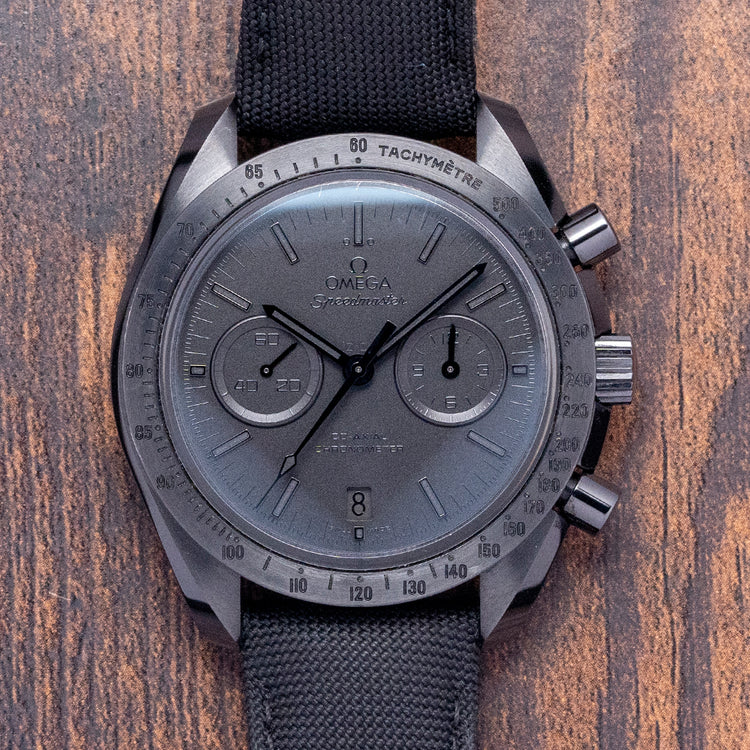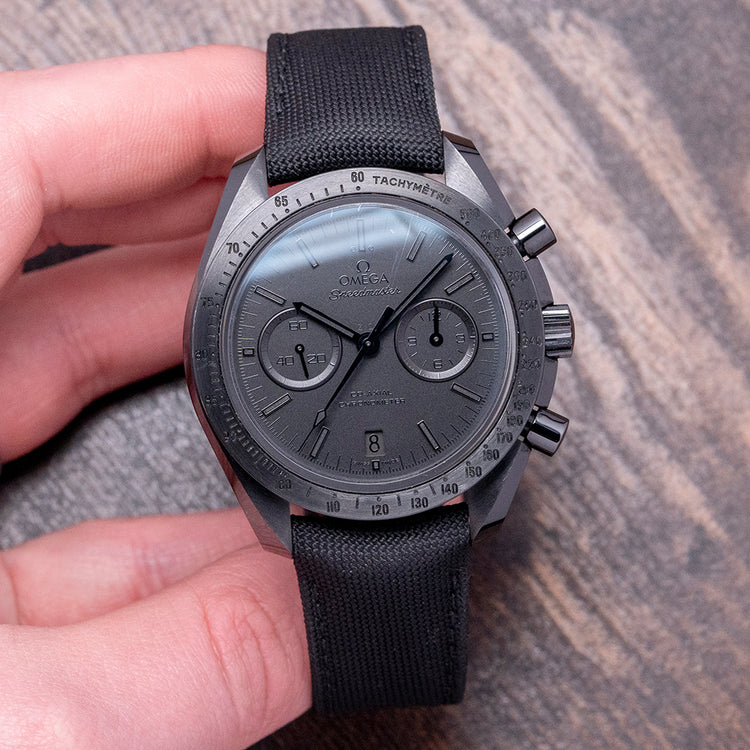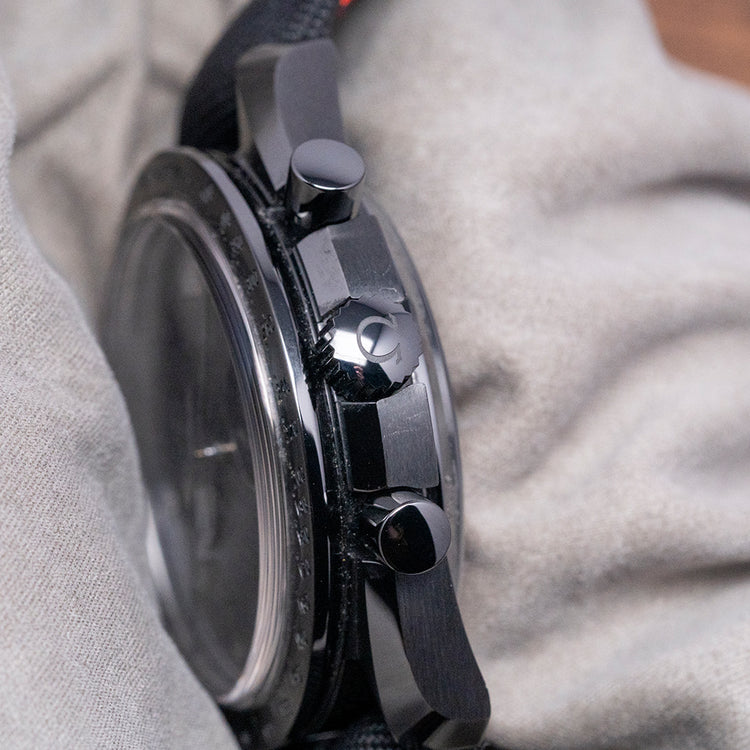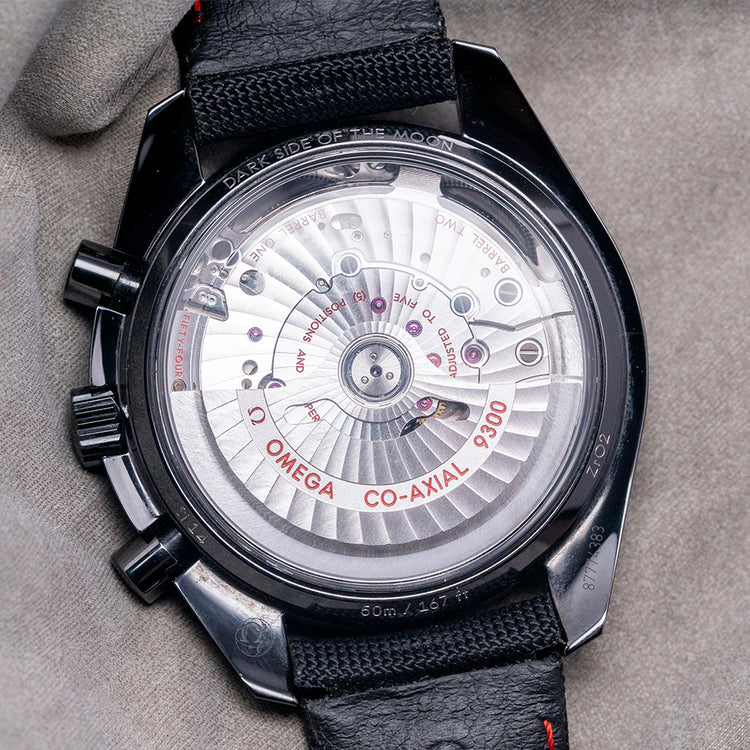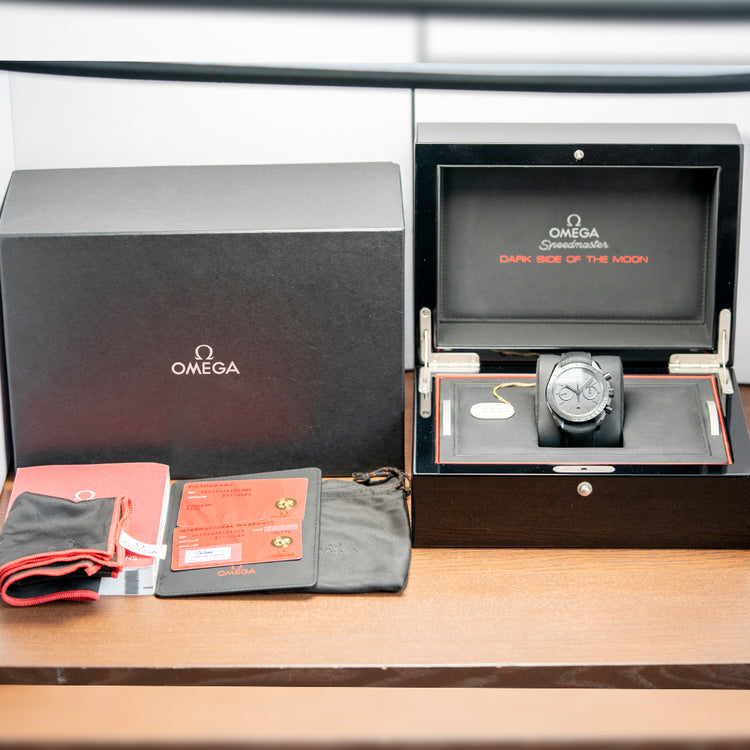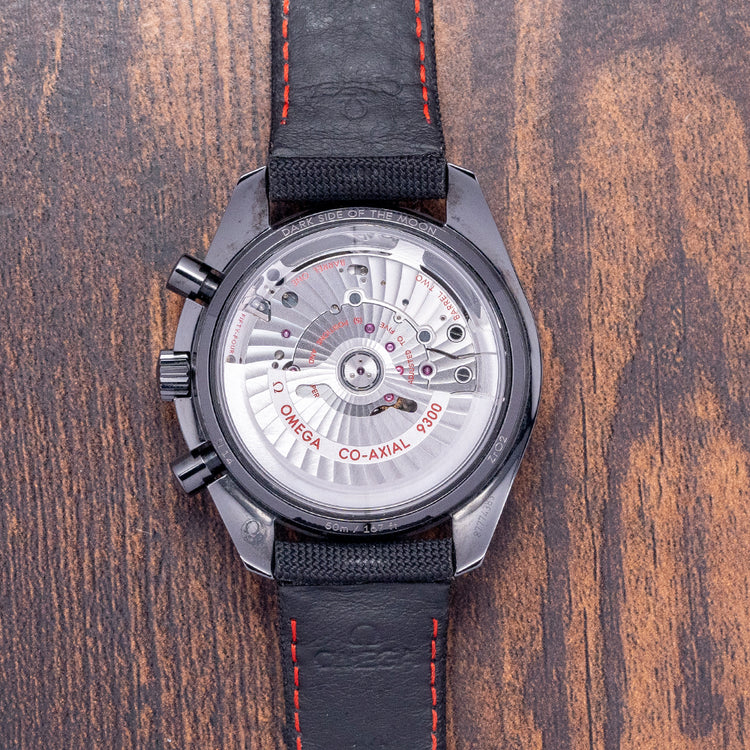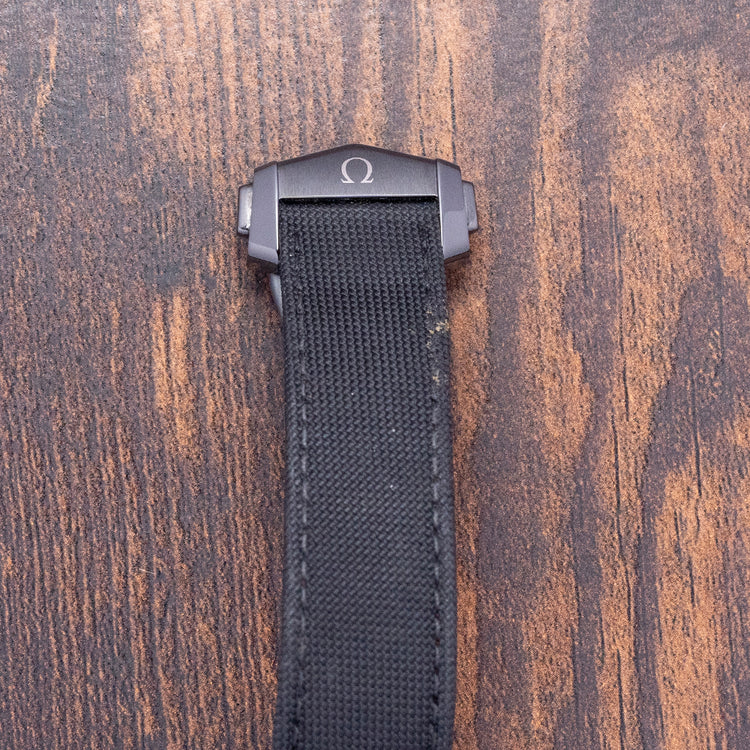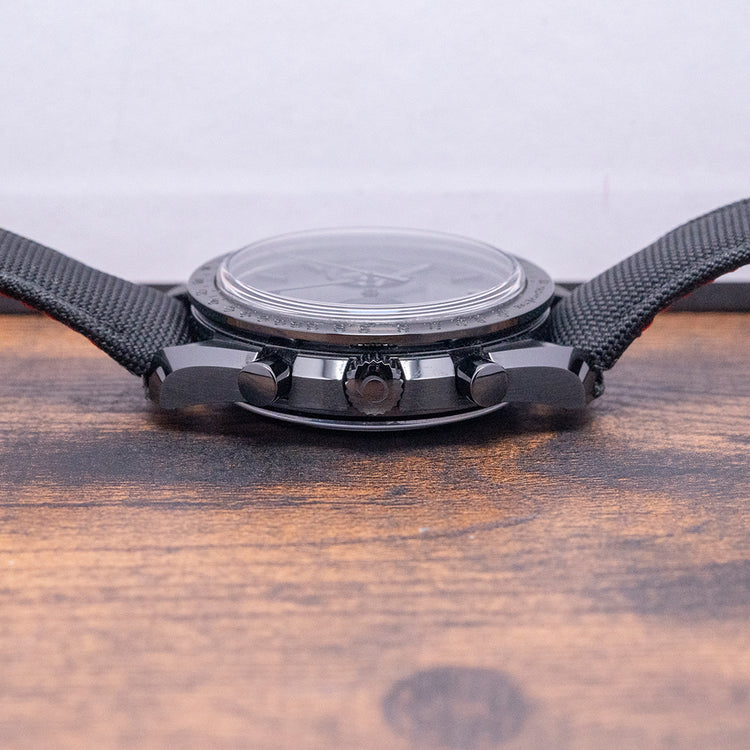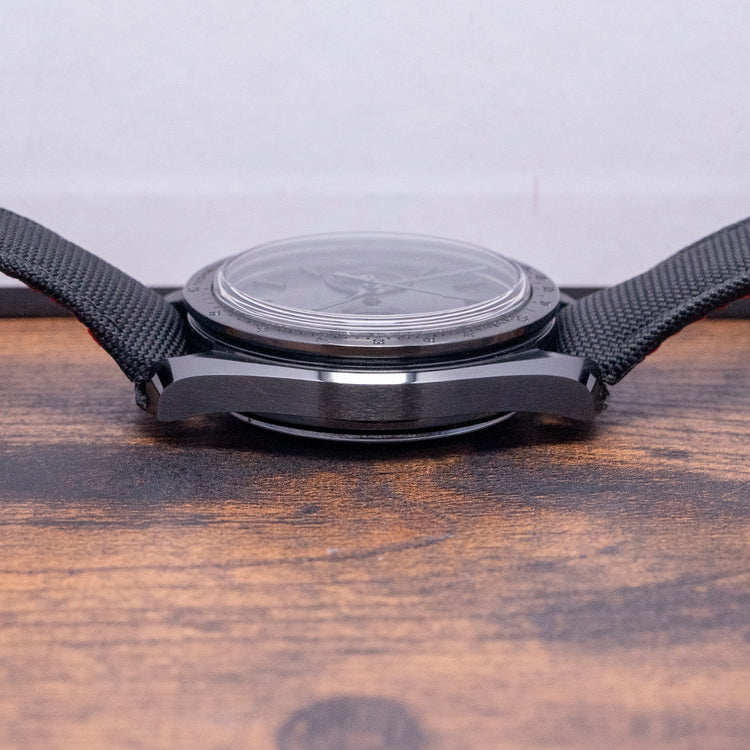More Information
Description
More
Less
Here we have a 2020 Omega Speedmaster Dark Side of the Moon with a 44.25mm polished and brushed Black Ceramic asymmetric case that curves over your wrist thanks to the characteristic twisted tapered lugs. Omega has spent many years working with and perfecting the use of Zirconium oxide ZrO2 Ceramic, which is two times lighter than stainless steel, non-magnetic, scratch-resistant and hard-wearing. Its curved flanks lead to a lug-to-lug length of 49.5mm and a case thickness of 16mm, giving the watch an impressive wrist presence. Down the right side, we have the chronograph pushers and a signed crown recessed into the case for protection. The ceramic bezel has a black lacquered Tachymeter scale and holds a domed sapphire crystal above a stealthy black ceramic bi-compax dial. An outer minute track is precisely executed surrounding applied black baton indexes coated in black Super-LumiNova marking the hours; at 3 o’clock a recessed 12-hour register; at 6 o’clock a colour-matched date window; and finally, at 9 o’clock, a recessed small seconds register, each with a polished ring and black numerals, slender brushed black sword hands coated in black Super-LumiNova are complemented by a black chronograph hand, at 12 o’clock we have the Omega motif “Speedmaster” underneath and at 6 o’clock “Co-Axial Chronometer” completes this Dark side of the Moon inspired bi-compax chronograph. On the reverse, a sapphire exhibition case back, etched with the details of the watch around its edge, inside a Rhodium plated automatic Omega Cal. 9300, features a column-wheel, a silicon balance wheel, and the George Daniels conceived Co-Axial escapement with twin barrels mounted in series, 54 jewels, beating at 28,800 beats per hour, designed for better durability, precision, and stability and decorated in Côtes de Genève. The watch comes paired with its 21mm Omega fabric strap, soft leather underside and secured by a signed Ceramic push button folding clasp. The watch comes with its Omega presentation box and paperwork.
Points of Mention
More
Less
Personal Note
More
Less
Specification
More
Less
Movement : Automatic Omega Cal. 9300
Age : December 2020
Year : 2020
Case Size : 44mm
Case Thickness : 16mm
Lug to Lug : 49.5mm
Lugs : 21mm
Condition : Pre-Owned
Box and Papers : Box and Papers
Case Material : Black Ceramic
Warranty : 12-Months Warranty
The wrist model's wrist size is 7inch
About Omega
More
Less
Description
Here we have a 2020 Omega Speedmaster Dark Side of the Moon with a 44.25mm polished and brushed Black Ceramic asymmetric case that curves over your wrist thanks to the characteristic twisted tapered lugs. Omega has spent many years working with and perfecting the use of Zirconium oxide ZrO2 Ceramic, which is two times lighter than stainless steel, non-magnetic, scratch-resistant and hard-wearing. Its curved flanks lead to a lug-to-lug length of 49.5mm and a case thickness of 16mm, giving the watch an impressive wrist presence. Down the right side, we have the chronograph pushers and a signed crown recessed into the case for protection. The ceramic bezel has a black lacquered Tachymeter scale and holds a domed sapphire crystal above a stealthy black ceramic bi-compax dial. An outer minute track is precisely executed surrounding applied black baton indexes coated in black Super-LumiNova marking the hours; at 3 o’clock a recessed 12-hour register; at 6 o’clock a colour-matched date window; and finally, at 9 o’clock, a recessed small seconds register, each with a polished ring and black numerals, slender brushed black sword hands coated in black Super-LumiNova are complemented by a black chronograph hand, at 12 o’clock we have the Omega motif “Speedmaster” underneath and at 6 o’clock “Co-Axial Chronometer” completes this Dark side of the Moon inspired bi-compax chronograph. On the reverse, a sapphire exhibition case back, etched with the details of the watch around its edge, inside a Rhodium plated automatic Omega Cal. 9300, features a column-wheel, a silicon balance wheel, and the George Daniels conceived Co-Axial escapement with twin barrels mounted in series, 54 jewels, beating at 28,800 beats per hour, designed for better durability, precision, and stability and decorated in Côtes de Genève. The watch comes paired with its 21mm Omega fabric strap, soft leather underside and secured by a signed Ceramic push button folding clasp. The watch comes with its Omega presentation box and paperwork.
Points of Mention
Personal Note
Specification
The Brand
Enquire or Book an Appointment
Would you like to discover further details about this watch, or perhaps arrange an appointment to view and try it on? Complete this form and a member of our team will get back to you shortly.
You May Also Like


























